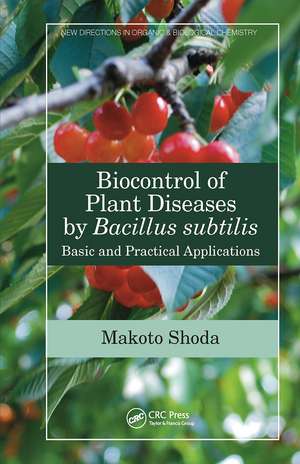Biocontrol of Plant Diseases by Bacillus subtilis: Basic and Practical Applications: New Directions in Organic & Biological Chemistry
Autor Makoto Shodaen Limba Engleză Hardback – 23 sep 2019
Features:
| Toate formatele și edițiile | Preț | Express |
|---|---|---|
| Paperback (1) | 437.67 lei 6-8 săpt. | |
| CRC Press – 30 iun 2021 | 437.67 lei 6-8 săpt. | |
| Hardback (1) | 1254.51 lei 6-8 săpt. | |
| CRC Press – 23 sep 2019 | 1254.51 lei 6-8 săpt. |
Preț: 1254.51 lei
Preț vechi: 1529.89 lei
-18% Nou
Puncte Express: 1882
Preț estimativ în valută:
240.08€ • 260.69$ • 201.67£
240.08€ • 260.69$ • 201.67£
Carte tipărită la comandă
Livrare economică 23 aprilie-07 mai
Preluare comenzi: 021 569.72.76
Specificații
ISBN-13: 9780367136109
ISBN-10: 0367136104
Pagini: 350
Ilustrații: 55 Tables, black and white; 100 Illustrations, black and white
Dimensiuni: 156 x 234 x 21 mm
Greutate: 1.5 kg
Ediția:1
Editura: CRC Press
Colecția CRC Press
Seria New Directions in Organic & Biological Chemistry
ISBN-10: 0367136104
Pagini: 350
Ilustrații: 55 Tables, black and white; 100 Illustrations, black and white
Dimensiuni: 156 x 234 x 21 mm
Greutate: 1.5 kg
Ediția:1
Editura: CRC Press
Colecția CRC Press
Seria New Directions in Organic & Biological Chemistry
Public țintă
Academic and Professional Practice & DevelopmentCuprins
Preface
Author
Chapter 1 Introduction
Chapter 2 In Vitro Selection of B. subtilis as a Candidate of Biocontrol Agent and Characterization of Suppressive Products
Chapter 3 In Vivo Plant Tests
Chapter 4 Stability of B. subtilis and Its Derivative Strains in Soil
Chapter 5 Development of Transformation Methods of B. subtilis and Cloning of Genes Responsible for Biosynthesis of Lipopeptide Antibiotics
Chapter 6 Genetic Analysis of B. subtilis Related with Production of Three Peptide Substances
Chapter 7 Optimization Study of Production of Antifungal Substances and Spores in Submerged Fermentation (SmF) or in Solid-State Fermentation (SSF)
Chapter 8 Surfactin Production and Plasmid Stability
Chapter 9 Co-Use of B. subtilis with Chemical Pesticide
Chapter 10 Mixed Culture Effect on Biocontrol
Chapter 11 Practical Application of B. subtilis in Fruit Gardens for Biocontrol of Diseases
Chapter 12 Conclusions
Author
Chapter 1 Introduction
Chapter 2 In Vitro Selection of B. subtilis as a Candidate of Biocontrol Agent and Characterization of Suppressive Products
Chapter 3 In Vivo Plant Tests
Chapter 4 Stability of B. subtilis and Its Derivative Strains in Soil
Chapter 5 Development of Transformation Methods of B. subtilis and Cloning of Genes Responsible for Biosynthesis of Lipopeptide Antibiotics
Chapter 6 Genetic Analysis of B. subtilis Related with Production of Three Peptide Substances
Chapter 7 Optimization Study of Production of Antifungal Substances and Spores in Submerged Fermentation (SmF) or in Solid-State Fermentation (SSF)
Chapter 8 Surfactin Production and Plasmid Stability
Chapter 9 Co-Use of B. subtilis with Chemical Pesticide
Chapter 10 Mixed Culture Effect on Biocontrol
Chapter 11 Practical Application of B. subtilis in Fruit Gardens for Biocontrol of Diseases
Chapter 12 Conclusions
Descriere
Plant diseases are a serious threat to food production. This unique volume provides the fundamental knowledge and practical use of B.subtilis as a promising biocontrol agent.
Notă biografică
The author, Dr. M. Shoda, started his academic career with undergraduate, and graduate courses in Biochemical Engineering at the University of Tokyo, Tokyo, Japan. His Ph.D. thesis was on the modeling and computer simulation of product inhibition in microbial reactions under the supervision of Professor S. Aiba, who was a pioneer in Biochemical Engineering. This work on the introduction of computers to modeling was the first trial in the microbial world, and his scientific paper received 40th Anniversary Award for Papers with Special Impact on Biotechnology (John Wiley and Sons, Inc.).
As assistant professor at Nagoya University, he gained experience in basic biochemistry and microbiology under the supervision of the late Professor S. Udaka, who was famous as the pioneer of producing amino acids using microbial reactions. He then moved to Tokyo Institute of Technology, where he concentrated on environmental biotechnology based on basic genetics and biochemistry, as well as computer control. As Director of the Research Laboratory of Resources Recycling Process, he supervised numerous graduate students who contributed to this book. He published more than 250 scientific papers, regarding isolation of several new microorganisms, including a new fungus that decomposes many toxic and colored chemicals by producing different unique enzymes, and a bacterium that converts ammonia directly to N2 gas without using conventional nitrification and denitrification processes at a 100-fold higher rate than the conventional method. He is active in research and application of microbial reactions as Professor Emeritus at Tokyo Institute of Technology.
As assistant professor at Nagoya University, he gained experience in basic biochemistry and microbiology under the supervision of the late Professor S. Udaka, who was famous as the pioneer of producing amino acids using microbial reactions. He then moved to Tokyo Institute of Technology, where he concentrated on environmental biotechnology based on basic genetics and biochemistry, as well as computer control. As Director of the Research Laboratory of Resources Recycling Process, he supervised numerous graduate students who contributed to this book. He published more than 250 scientific papers, regarding isolation of several new microorganisms, including a new fungus that decomposes many toxic and colored chemicals by producing different unique enzymes, and a bacterium that converts ammonia directly to N2 gas without using conventional nitrification and denitrification processes at a 100-fold higher rate than the conventional method. He is active in research and application of microbial reactions as Professor Emeritus at Tokyo Institute of Technology.











